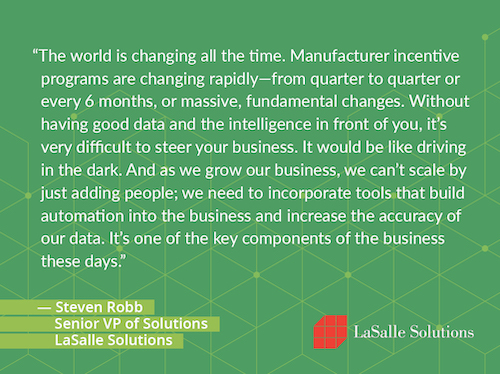Automating the Customer Engagement Lifecycle
The fundamental challenges to profitability across the sales lifecycle are the need to gather data from many complex data sources, analyze it, and use the results to optimize profitability. Sales process automation does just that, sheltering the user from complexity and significantly increasing efficiency and profitability.
Areas ripe for automation
There are usually several organizations involved in the life of a deal. The deal typically starts with the sales architect or engineer employing a discovery process to baseline an existing network and create a design or proposal. The vendor’s online ordering system is then used to create an estimate, which is the initial proposal. That estimate gets registered as a deal to determine the costs and basic discount. The solution provider can then analyze the deal to optimize its margin. This can include understanding costs, applying incentives and rebates, and doing “what-if” analyses against competitors. Margin dollars can then be distributed across products, subscriptions, and professional services to yield the most profitable proposal.
Teams such as the deal desk often manage back-end promotions to ensure, for example, that booking targets and shipment dates required to qualify for rebates are met. Further along the sales cycle, the sales team works with its customers on subscription and support contract renewals, replacements, and upsell and cross-sell opportunities for customer assets that may be reaching end-of-life, end-of-support, and so on.
Automation can streamline end-to-end sales operations by gathering and analyzing data from a variety of sources and providing the resulting insights in dashboards. This way, solution providers can spend their time focusing on their customers and their business instead of grinding through data.
Automation across the sales lifecycle
A deal goes through many steps during its life, with countless opportunities for automation, optimization and analysis.
Margin and competitive analyses
With the tremendous competitive pressure to get profitable quotes out quickly, margin and incentive optimization is frequently skipped or done with spreadsheets for the largest deals. Instead, automated processes should be designed to identify all the incentives that apply to a deal, incorporate professional services costs, calculate rebates, and determine the deal’s margin. Sale teams should be able to test “what-if” pricing scenarios to determine how much discounting they can do and be able to move margin between product, service, and subscriptions to help determine their best sales-focused cost and price strategy. In addition, gaining understanding of where competitors may stand based on their certifications and specializations and potential costing structures can facilitate winning more deals. And it must be done so quickly and reliably that the analysis can be done on every deal.
Using automated applications that put the deal analysis information at the fingertips of the sales team will enable them to take advantage of programs and promotions and understand their end-to-end deal profitability. Because the business is very commoditized, small changes can have big impact, so thoroughly analyzing deals up front enables the solution provider to be more competitive.




















